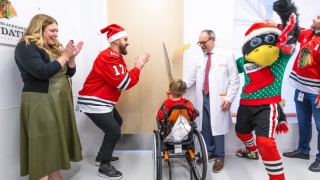Body
There are several options currently available for the one-handed typist. Asking yourself the following questions may be helpful before deciding which option is best for you.
1. Amount of time using the computer?
2. Number of words per minute (wpm) one can type?
3. Ability to stick with the selected option?
4. Is unaffected hand/arm strong enough to do all the work?
5. Will the affected arm/hand improve over time?
6. Will the affected hand be able to push 1 or 2 keys?
7. Will more than one computer need to be used?
8. How much time will I have to put into learning a new system?
Looking at the advantages and disadvantages of various computerized options may help you decide which one is best for you.
The following changes can easily be made to your computer to improve speed and accuracy.
• Sticky Keys: Adapts the need for multiple keystroke commands (Shift, ctrl, alt, functions), by allowing user to hit keys in succession. Available in Windows through “Ease of Access” and in Mac OS under Accessibility from System preferences.
Abbreviation Expansion Options
Abbreviation-expansion is a technique in which a combination of letters, an "abbreviation," is used to represent a word or phrase. When you type an abbreviation followed by the Spacebar or Enter key, it expands to the assigned word or phrase. You can create your own set of abbreviations that are easy for you to use and remember.
For example, the Technology Center for the Environment, Computer and Communication could be abbreviated by TC.
The benefits for using abbreviation options are that they may:
• Reduce the number of keystrokes required
• Increase rate of text input
• Decrease fatigue/pain.
NOTE: This option can be found under Auto Correct or Abbreviation Expansion in MS Word Tools
Alternative Hand Placement Options (Teach a new technique for 1-handed touch typing).
Five Finger Typist: A tutorial program that helps you learn how to keyboard effectively with one hand. An animated on-screen tutor illustrates the hand movements through a series of typing exercises. The program can keep track of typing accuracy and progress via printouts. Available for Windows or Mac.
Advantages:
• This program and others like it teaches a new technique for one-handed typing.
• Once learned, the skill can be applied to any keyboard or typewriter.
Disadvantages:
• Moving across the entire keyboard may lead to early fatigue or pain for the unaffected hand.
• May be difficult and time consuming if not a touch typist previously.
Dvorak
Developed by Dr. August Dvorak after WWII to meet the needs of a one-handed soldier. Based on his two-handed frequency of use layout, the one-handed version places the most frequently used letters within easy reach on either hand. Tutorials are available. Specialty designed keyboards are available; however, keyboards can be converted within Windows 95 and Macintosh operating systems within the control panel. Some systems do not have the right and left-handed Dvorak keyboards installed. In these cases, it is a simple matter of loading them using downloadable files. Stickers are available from various sources to re-label the keyboard keys.
Advantages:
• Easy conversion without special software.
• Keys are in frequency of use patterns, which reduces fatigue.
• Learning may be quick if you were already a touch typist.
Disadvantages:
• Must learn or relearn a new keyboard layout.
• Initial speeds may be slow if you were not a touch typist previously but should roughly take the time it would take to learn standard two-handed touch-typing.
• If sharing the same computer with others, must create specific user profiles or the other users must know how to switch keyboard layout.
Voice Input Systems (i.e., Dragon)
Speech Recognition allows you to control your computer by voice. Using only your voice, you can start programs, open menus, click buttons and other objects on the screen, dictate text into documents, and write and send e-mails. Just about everything you do with your keyboard and mouse can be done with only your voice. These systems require a relatively clear, consistent voice and voice patterns and some amount of learning, however, can be very functional. Dragon Naturally Speaking comes in different versions for Windows. Mac OS Voice Control and Windows 11 Voice access can also be considered.
Advantages:
• Has the potential to be up to 3x faster than typing.
• Able to use some with Bluetooth headsets.
• Customizable command option in some versions.
• Does not cause hand strains.
Disadvantages:
• Voice training process could be long if voice quality is decreased.
• If using more than one computer, software would need to be installed on each.
• Dictating could be distracting to others in the surrounding environment.
Alternate Keyboards
Non-standard keyboards that are designed to increase ease of use for some populations or specifically made for one-handed use.
TAP Keyboard: TAP is a set of connected silicone rings, which fit snugly onto the fingers of your dominant hand and are adjusted using nylon sliders on the palm side. The thumb ring bears the power button, plus a flat edge that serves as a mouse, letting you scroll around webpages and documents by sliding it across any surface.
To type, you just tap your fingers against whatever comes to hand. That could be a table, the arm of a chair, the back of your other hand, your sleeve – anything hard enough to stop your fingers moving. Different combinations of fingers produce different letters, and with practice, some can type 50wpm single-handed.
Half-Qwerty Keyboard: A standard desktop keyboard that allows those with limited or no use of one hand to continue typing with the other hand in an easy and natural manner.
Advantages:
• If you know the standard QWERTY keyboard layout, you know how to use Half-Qwerty.
• Works with any Windows or Macintosh application.
• Easy on/off Sticky keys feature • Can be used by two-handed typists.
Disadvantages:
• Hunt and peck typists will have a difficult time; these typists will need to learn the keyboard layout.
• Higher cost than some other options.



